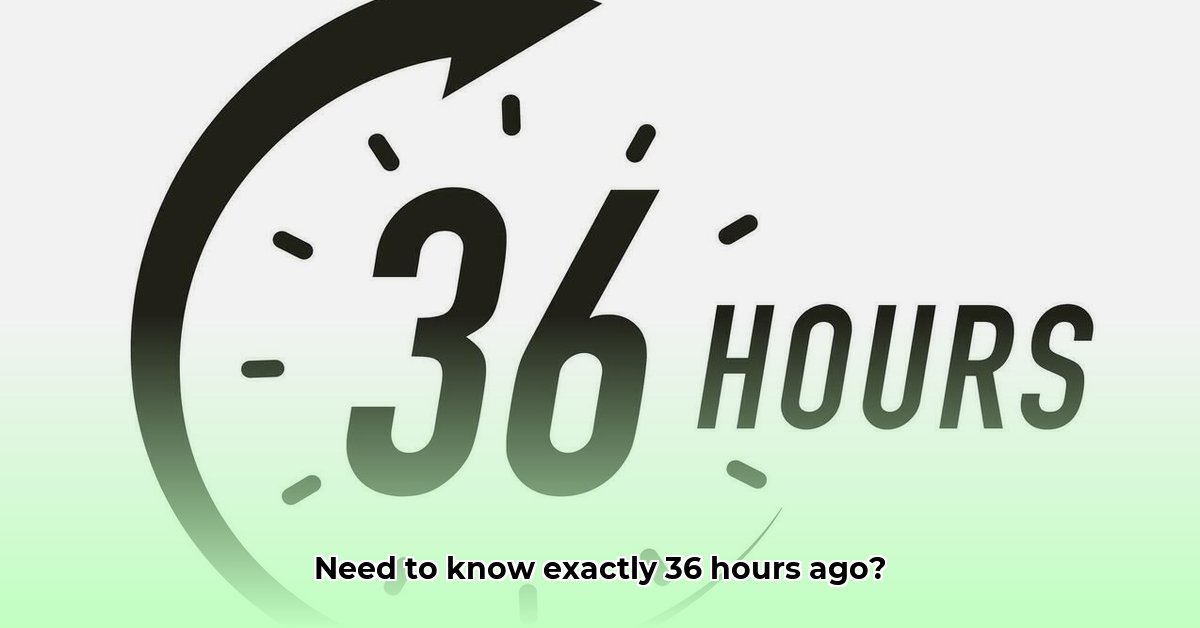
36 Hours Ago: Mastering Precise Time Calculations
Determining the exact date and time 36 hours prior to a given moment seems straightforward, but inherent complexities often lead to inaccuracies. This guide explains the common pitfalls and provides a comprehensive approach to precise time calculation, benefiting both end-users and developers.
The Importance of Precise Time Tracking
While estimations like "2 hours ago" are generally sufficient for informal communication, many scenarios demand exactness. Legal proceedings, financial transactions, and critical scheduling require pinpointing the precise date and time, emphasizing the need for robust time calculation tools. Consider the implications of a one-hour error in a financial report – how might this impact regulatory compliance or financial analysis? The need for accuracy cannot be overstated.
Current Limitations of Time Calculation Tools
Currently available online calculators often handle basic time conversions, but frequently lack crucial features. The most glaring omissions include: consistent handling of time zones and daylight saving time (DST), and sophisticated error handling. These deficiencies underscore a need for improvement in the accuracy and functionality of these tools.
Identifying Shortcomings in Existing Tools
What features are missing from current time calculators? The ability to predict recurring events, seamless calendar integration, and user-friendly interoperability with other applications are notably absent. This lack of advanced functionality hinders effective time management and productivity.
Building Superior Time Calculation Tools: A Developer's Guide
To create more effective tools, developers must address several critical areas:
Robust Time Zone Handling: Integrate well-maintained time zone libraries capable of accurate DST adjustments. Rigorous input validation is essential to prevent errors.
Comprehensive Error Handling: Implement error handling that provides clear, user-friendly messages, guiding users towards accurate input. Generic error messages are unacceptable; the user needs specific guidance and clear feedback on how to correct the issue.
Streamlined App Integrations: Develop a well-documented Application Programming Interface (API) to enable seamless integration with other applications and systems.
Scalable Architecture: Employ cloud-based infrastructure to ensure responsiveness even during high usage periods.
| Feature | Importance | Current Status | Improvement Strategies |
|---|---|---|---|
| Time Zone Handling | Critical | Often Deficient | Robust libraries, thorough input validation |
| DST Adjustment | Critical | Inconsistent | Automatic updates, built-in DST correction |
| Error Handling | High | Inadequate | Clear, informative error messages, input validation |
| App Integration | High | Limited | Well-documented API for seamless integration |
| User Interface | Moderate | Often Basic | Intuitive design, clear input/output |
A User's Guide to Accurate Results
Even with advanced tools, correct usage is paramount. To accurately calculate the time 36 hours prior:
Precise Time Zone Specification: Always specify your time zone (e.g., "36 hours ago in PST").
Consider Daylight Saving Time: Ensure that DST transitions are accurately accounted for by the tool.
Regular Updates: Keep the tool updated to benefit from bug fixes and improved time zone data. Regular updates ensure the tool remains accurate and current.
Choosing the right time calculation tool is crucial. The consequences of inaccurate time calculations, particularly in critical contexts, can be significant. Thorough research and careful selection are recommended.
How to Accurately Convert Relative Timestamps to Precise Dates and Times
Converting relative timestamps (e.g., "2 days ago") to precise dates and times, particularly across different time zones, introduces significant challenges.
Challenges in Relative Timestamp Conversion
The inherent ambiguity of relative timestamps is the primary hurdle. "Yesterday" varies by location. The conversion needs a reference point—the time the relative timestamp was generated. This usually needs to be incorporated into the metadata associated with the timestamp.
Step-by-Step Conversion Guide
Pinpoint the Reference Point: Identify the exact creation time of the relative timestamp (often embedded in data).
Determine the Time Zone: Locate the timezone associated with the reference point, either explicitly stated or inferred.
Precise Duration Calculation: Translate the relative timeframe ("2 days ago") into a precise duration (e.g., 48 hours).
Apply Duration, Account for DST: Add or subtract the duration from the reference point, carefully handling DST transitions.
Optional Time Zone Conversion: Convert the result to the desired time zone using suitable libraries (e.g., Python's
pytzor JavaScript's Moment.js).
Recommended Tools and Techniques
Programming languages like Python (with datetime and pytz) and JavaScript (with Moment.js or Luxon) offer robust timezone handling capabilities. Careful error handling is essential.
Practical Considerations for Accurate Conversion
Data Integrity: Accurate conversions rely on consistent, reliable data. Verify the accuracy and completeness of relative timestamps and associated metadata.
User-Friendly Interface: Present results clearly using standardized formats (e.g., ISO 8601), considering user preferences for 12-hour vs. 24-hour clocks.
Robust Error Handling: Implement comprehensive error handling to manage invalid timestamps and timezone issues gracefully.
Comparing Different Conversion Approaches
| Approach | Advantages | Disadvantages |
|---|---|---|
| Programming Libraries | Efficient, accurate, handles time zones, readily available | Requires programming skills, potential dependency issues |
| Manual Calculation | No dependencies, suitable for simple cases | Prone to errors, tedious for complex scenarios, lacks timezone handling |
Key takeaway: Accurate relative timestamp conversion requires a precise reference point, meticulous timezone handling, and robust error management. Utilize appropriate programming libraries for optimal results.